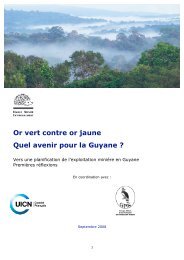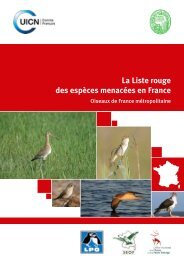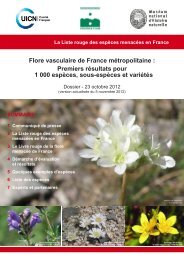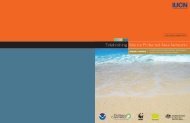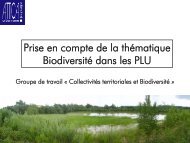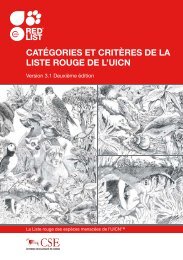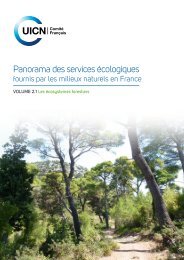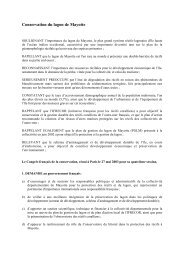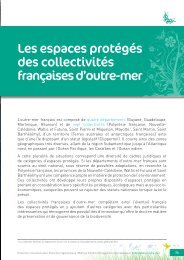Synthèse par collectivité et annexes - Especes-envahissantes ...
Synthèse par collectivité et annexes - Especes-envahissantes ...
Synthèse par collectivité et annexes - Especes-envahissantes ...
Create successful ePaper yourself
Turn your PDF publications into a flip-book with our unique Google optimized e-Paper software.
Lowe, S., Browne, M., Boudjelas, S., & De Poorter, M. (2000). 100 of the world's worst invasive alien species A selection from the Global Invasive<br />
81 Species database. Published Group (ISSG) a specialist group of the Species Survival Commission of the World Conservation Union (IUCN). ISSG-<br />
IUCN.<br />
82<br />
Frenot, Y., Gloaguen, J.C., & Trehen, P. (1997). Climate change in Kerguelen Islands and colonisation of recently deglaciated areas by Poa<br />
kerguelensis and Poa annua. Antarctic communities : species, structure and survival. 358-366.<br />
83<br />
Chapuis, J.L., Frenot, Y., & Lebouvier, M. (2004). Recovery of native plant communities after eradication of rabbits from the subantarctic Kerguelen<br />
Islands, and influence of climate change. Biological Conservation, 117 : 167-179.<br />
84<br />
Haysom, K.A. & Murphy, S.T. (2003). The status of invasiveness of forest tree species outside their natural habitat: a global review and discussion<br />
paper. Forest Health and Biosecurity Working Paper FBS/3E. Rome, FAO.<br />
85<br />
Gargominy, O., Bouch<strong>et</strong>, P., Pascal, M., Jaffré, T., & Tourneur, J.C. (1996). Conséquences des introductions d'espèces animales <strong>et</strong> végétales sur la<br />
biodiversité en Nouvelle-Calédonie. Revue d'Ecologie (La Terre <strong>et</strong> la Vie), 51 : 375-401.<br />
Lavergne C. (2005). Invasion <strong>par</strong> les plantes exotiques <strong>envahissantes</strong> dans une île océanique : Impact écologique à la Réunion <strong>et</strong> valeur<br />
86 patrimoniale des écosystèmes indigènes envahis. Rapport final, Programme de Recherche sur les Invasions Biologiques INVABIO, Conservatoire<br />
Botanique National de Mascarin <strong>et</strong> Université de la Réunion, 152 p. + <strong>annexes</strong>.<br />
87<br />
Vos, P. (2004). Case Studies on the Status of Invasive Woody Plant Species in the Western Indian Ocean. 2. The Comoros Archipelago (Union of the<br />
Comoros and Mayotte). FAO.<br />
88<br />
Barreau, J., Devambez, L. (1957). Quelques remarques inattendues de l’acclimatation en Nouvelle-Calédonie. Revue d'Ecologie (La Terre <strong>et</strong> la vie),<br />
4 : 324-334.<br />
89<br />
Macdonald, I.A.W. (1989). Report on the alien plant problem in Réunion. Percy Fitzpatrick Institute for African Ornithology, University of Cape<br />
Town.<br />
90<br />
Pons, J.M., Volobouev, V., Ducroz, JF, Tillier, A. <strong>et</strong> Reud<strong>et</strong>, D. (1999). Is the Raccoon of Guadeloupe really an endemic species? New insights based<br />
on a molecular and karyological study. J. Zool. Syst. Evol. Research, 37 : 101-108.<br />
91<br />
Helgen, K. M., Maldonado, J. E., Wilson, D. E., & Buckner, S. D. (2008). Molecular confirmation of the origin and invasive species status of West<br />
Indian raccoons. Journal of Mammalogy 89 (2): 282-291.<br />
92 Helgen, K.M. & Wilson, D. (2002). The history of raccoons of the West Indies. Journal of the Barbados Museum and Historical Soci<strong>et</strong>y 47 : 1-11.<br />
93<br />
Helgen, K.M. & Wilson, D. (2003). Taxonomic status and conservation relevance of the raccoons (Procyon spp.) of the West Indies. J. Zool. Lond.<br />
259 : 69-76.<br />
94<br />
Macdonald, I.A.W., Thébaud, C., Strahm, W.A., & Strasberg, D. (1991). Effects on alien plant invasions on native végétation remnants on La<br />
Reunion (Mascarene Islands, Indian Ocean). Environmental Conservation, 18 : 51-61.<br />
95<br />
Bar<strong>et</strong>, S., Roug<strong>et</strong>, M., Richardson, D. M., Lavergne, C., Egoh, B., Dupont, J., & Strasberg, D. (2006). Current distribution and potential extent of the<br />
most invasive alien plant species on La Réunion (Indian Ocean, Mascarene islands). Austral Ecology, 31 : 747-758.<br />
96 Triolo, J. (2006). Plan de gestion de la Réserve Naturelle de Mare Longue (2007-2011). ONF, DR, Réunion.<br />
97<br />
Grandgirard, J., Hoddle, MS., Roderick, GK., P<strong>et</strong>it, JN., Percy, D., Putoa, R., Garnier, C., & Davies, N. (2006). Invasion of French Polynesia by the<br />
glassy-winged sharpshooter, Homalodisca coagulata (Hemiptera: Cicadellidae): A new threat to the South Pacific. Pacific Science, 60 : 429-438.<br />
98<br />
Hoddle M.S., Grandgirard J., P<strong>et</strong>it J., Roderick G.K., & Davies N.. (2006). Glassy-winged sharpshooter Ko'ed - First round - in French Polynesia.<br />
Biocontrol News and Information 27(3): 47-62.<br />
99<br />
P<strong>et</strong>it, J., Hoddle, M. S., Grangirard, J., Roderick, G. K., & Davies, N. (2007). Invasion dynamics of the glassy-winged sharpshooter Homalodisca<br />
vitripennis (Germar) (Hemiptera: Cicadellidae) in French Polynesia. Biological Invasions<br />
100<br />
Le Bourgeois, T. (1998). Etude sur la lutte biologique contre la peste végétale Rubus alceifolius à la Réunion. Etape 1, Bibliographie. CIRAD,<br />
Montpellier, France.<br />
101<br />
Le Bourgeois, T. & Amsellem, L. (1999). Etude sur la lutte biologique contre la peste végétale Rubus alceifolius à La Réunion, Etape n°2 Etude de<br />
diversité génétique. CIRAD, Montpellier, France.<br />
102<br />
Lorvelec, O. & Pascal, M. (2005). French attemps to eradicate non-indigenous mammals and their consequences for native biota. Biological<br />
Invasions, 7 : 135-140.<br />
103<br />
Le Bourgeois, T., Camou, R., & Ehr<strong>et</strong>, P. (2006). Analyse de risque phytosanitaire - Appui à la rédaction de la réglementation spécifique aux<br />
dé<strong>par</strong>tements d'outre-mer. Cas des plantes <strong>envahissantes</strong>. Poseidom, Cirad, Dgal-Sdqpv, Montpellier, France.<br />
104 Fiard, J.P. (1992). Arbres rares <strong>et</strong> menacés de la Martinique. Conseil Régional de la Martinique. Sociétés des Galeries de Géologie <strong>et</strong> de Botanique.<br />
105<br />
Breuil, M. (2003). In the footsteps of French naturalists, a ""battle"" of iguanas and ""improvements"" in biodiversity. Island and the sea. Essays<br />
on herp<strong>et</strong>elogical exploration in the West Indies. R. W.Henderson and R. Powell : 255-269."<br />
106 Pinchon, R. (1967). Quelques aspects de la nature aux Antilles. Fort de France, Martinique.<br />
107 Bon Saint Côme, M. & Tanasi, M. (1994). Le Racoon en Martinique. Rapport Office National de la Chasse. Fort de France, Martinique, 15 p.<br />
108 Koening, S. (2000). Evaluation préliminaire des risques relatifs au lâcher de perroqu<strong>et</strong>s en Martinique., Association le Carouge : 26.<br />
109<br />
Barré, N., Feldmann, P., Tayalay, G., Roc, P., Anselme, M. & Smith, W. (1997). Introduction <strong>et</strong> extension de la Tourterelle turque Streptopelia<br />
decaocto dans les P<strong>et</strong>ites Antilles. Alauda 65(3) : 245-250.<br />
174



